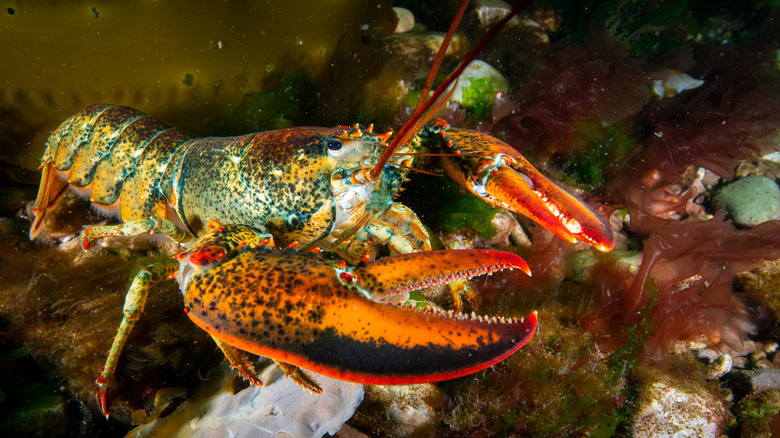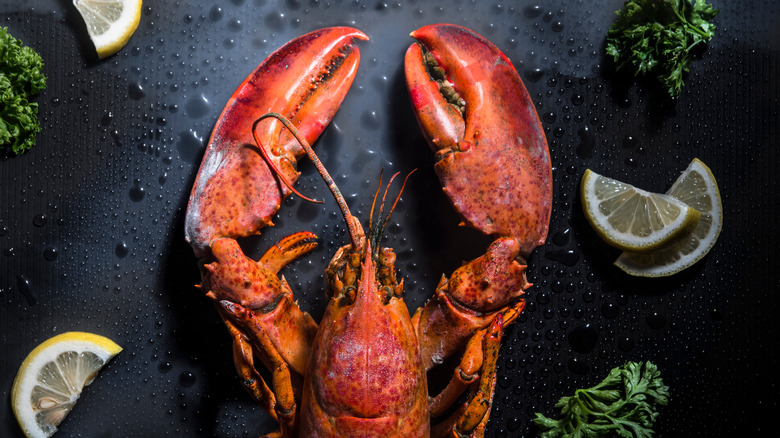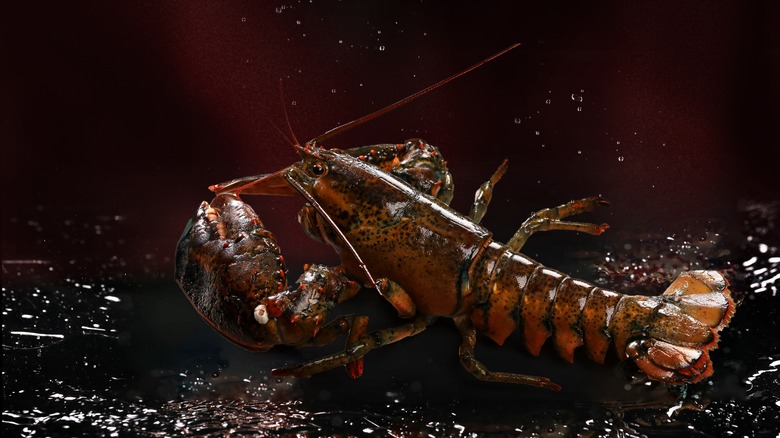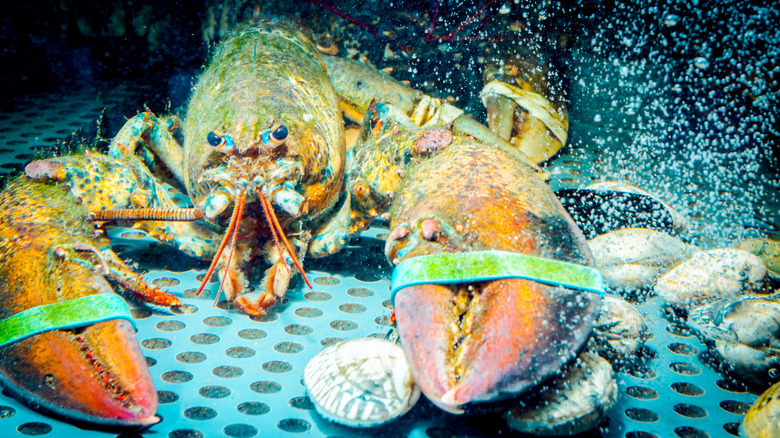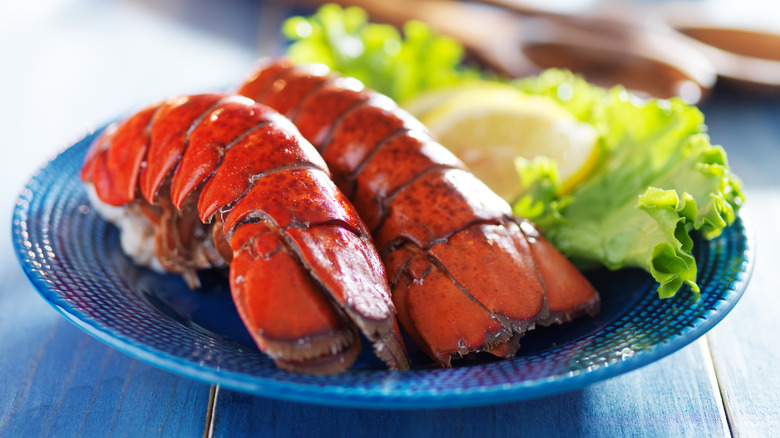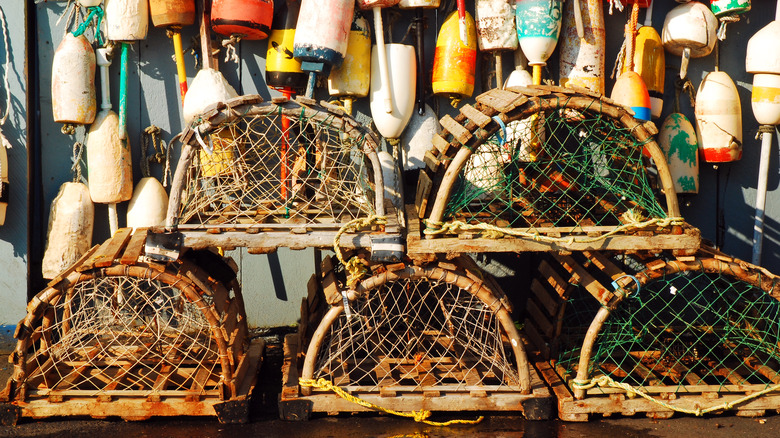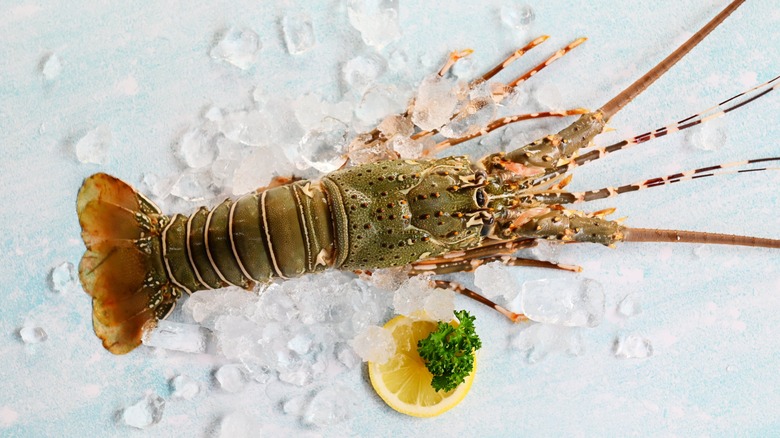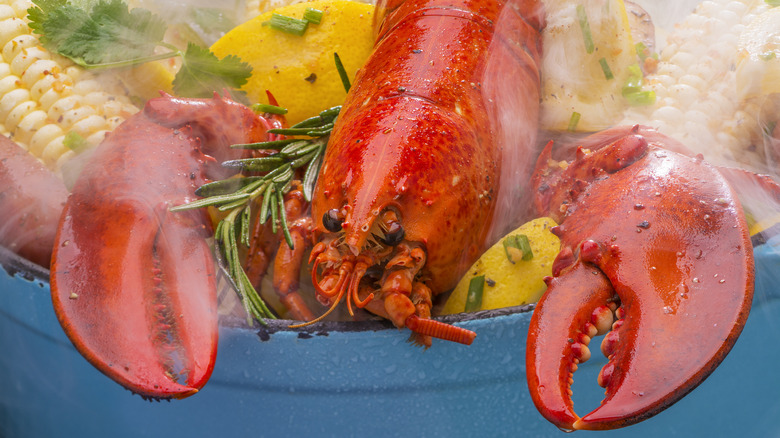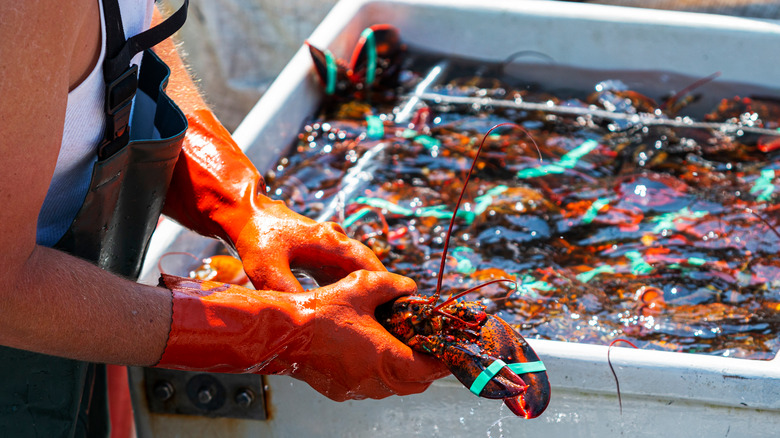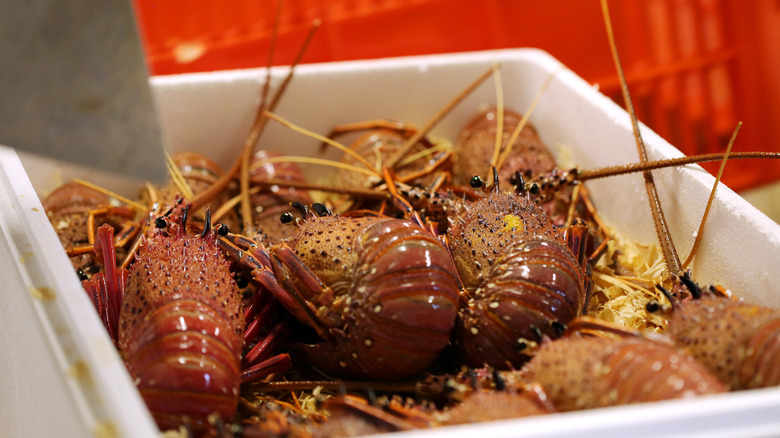10 Mistakes To Avoid When Buying Fresh Lobster
Many people consider lobster to be a delicacy, although it wasn't always held in such high regard. During the American colonial era, these so-called "cockroaches of the sea" were so abundant in coastal waters and cost so little that they were fed to prisoners and slaves, ground up for fertilizer, or eaten by regular people in secret to avoid shame. Today, eating lobster is a gourmet experience many people save for special occasions.
Purchasing live lobster may feel overwhelming if you don't know what to look for. Perhaps you're confused by the 16 types of lobsters or you're not sure where they should come from. Lobsters are quite perishable and usually carry a high price tag, so you'll want to protect your investment by bringing home healthy lobsters that aren't at death's door. Then there's the question of how exactly you'll get a live creature with giant claws home.
We reached out to experts in the field to simplify the buying experience for you. Ben Conniff is the co-founder and chief innovation officer of Luke's Lobster, a family-owned seafood business in Maine that ships live Maine lobster anywhere in the US. Keith Laudeman is the owner of The Lobster House restaurant and fish market in Cape May, NJ, whose menu and market feature live lobster specialties. Whether you live near the coast or you're a definite landlubber, read on for advice that will take the stress out of buying this gourmet crustacean.
Choosing the wrong size lobster
Lobsters exist in many sizes, ranging from under Maine's legal size of one pound to jumbo lobsters weighing up to four pounds. The largest American lobster ever caught weighed 45 pounds, but some regions require those over a certain size to be thrown back to preserve older lobsters. But does size matter? Opinions differ on whether the meat of larger lobsters is tougher. "It's also typically cost-prohibitive to buy really big lobsters, and the smaller ones still yield plenty of yummy, tender lobster meat," Conniff says. If the cost is an issue, you can ask if there are any culls, which are lobsters missing a claw and sold for less.
Plan to purchase live lobsters weighing about one and a quarter to two pounds per person. Laudeman points out that small lobsters aren't easier to cook, but they do take less time. Whether you're going to cook your lobsters by steaming, boiling, or roasting, it will be easier to fit them in the pots you have in your kitchen. The biggest confusion may be how long to cook lobsters at home. Conniff says: "Our rule of thumb is to cook them for about 10 minutes per pound. But what you're really looking for is a bright red shell color across the whole lobster and white, opaque meat. Overcooking can lead to a tough, chewy lobster meat."
Buying soft-shell lobsters
Soft-shell and hard-shell lobsters are the same kind of lobsters at different stages of growth. Soft-shell lobsters have recently molted and have a thinner, softer shell. Hard shell lobsters are heavier, have more meat inside, and have shells that take more muscle to crack. Learning how to remove lobster meat from the shell first can streamline buying either type. "Also, know that when you get a soft-shell lobster, the size of the meat inside will be much smaller than the shell you see on the outside," says Conniff. "That's because they haven't grown into their new shell yet! As long as you plan accordingly and expect it, you'll still really enjoy the amazing tender and sweet meat inside."
Differentiating between soft-shell and hard-shell lobsters is pretty straightforward, but determining which kind to eat is a matter of personal taste. Laudeman believes the firmer hard shell meat has a more desirable taste and texture and considers soft-shell lobster meat to be soft and mushy. Conniff says: "Both hard shell and soft-shell lobsters are delicious in their own right... many people, including us, think that soft-shell lobsters are sweeter and more tender than their hard shell counterparts."
It's important to note that if you choose soft-shell lobsters, it's better to eat them locally rather than ordering them online. Conniff explains: "Soft-shell, or new-shell, lobsters don't ship well because they are fragile. They have recently molted their exoskeleton and created a whole new one, which makes them weaker and more susceptible to the elements."
Not checking for signs of life
Have you ever wondered why seafood markets feature saltwater tanks with live lobsters inside while other types of seafood are laid out on beds of ice? Whole lobsters are kept alive before purchase because they spoil rapidly after death. Enzymatic breakdown also causes the flesh to become mushy in less than an hour. Immediately cutting off the head will stave off decay since the head area contains the guts and gills. That's why tails and claws can be frozen for shipping. But if the lobster is whole, make sure it's alive.
Conniff drives this point home: "You should absolutely never eat any lobster that is dead (before cooking) or appears lethargic and doesn't move around when you handle it. If their claws droop or their tail doesn't recoil when you straighten it, that's probably a good indication that they're weak and not a great option. You want the freshest, liveliest lobster possible!"
Checking for these signs of life will ensure you don't bring home a sleeper, a term that refers to a lobster that has been in a tank for an extended period of time, moves slowly like a zombie, has lost weight, and is close to death. "A live lobster should appear alive," Laudeman states. He explains that this includes having a clean and shiny shell, legs that don't hang loose when you pick it up, and a feisty feel.
Getting hung up on whether it's male or female
Does the sex of a lobster matter? There's no real need to get hung up on whether a lobster is male or female. "It absolutely does not matter!" Conniff says. "There are very few noticeable differences in male and female lobsters." Conniff explains that the tails of females are wider because they have more space to carry eggs, whereas the claws of males are usually larger. These differences are not game changers, as the taste is exactly the same. If you just really want to know, you can inspect the first pair of small legs, called swimmerets, at the junction of the body and tail. You'll find that males have stiffer swimmerets covered by a hard shell, while those of the females are softer and lighter.
"You are more likely to find male lobsters, however," says Conniff, "because there are many more regulations around throwing egg-bearing females back and marking them with a V-shaped notch so they can never be kept, even if the next time you catch them they don't have eggs on them." Some people seek out females because they deem the eggs a delicacy, but the reason many areas make it illegal to keep them is to ensure the species' survival.
Worrying about where the lobster was caught
Conniff shares: "Maine and Canada are both well-managed lobster fisheries that have some of the best-tasting lobster in the world. Yes, you can get other kinds of lobster (like spiny lobster), but in our opinion, Maine and Canadian lobsters are best."
Many people share this opinion, at least about Maine lobster, which has a widespread reputation for having the lobster with the most desirable taste. But before you make the mistake of rejecting lobster from other areas, you should know that Maine and Canadian lobsters are exactly the same. Yes, they are both the same species called Homarus americanus, more commonly known as the American lobster, and they live in the same ocean.
Depending on when you shop, though, you may be more likely to encounter Maine lobsters since fishing is allowed year-round in that state, whereas it's only allowed at certain times of the year in Canada. Rather than seeking lobster from certain areas, focus on the quality of the lobster instead, checking it for the signs of good health outlined above.
Buying rock lobster or spiny lobster instead
Maine lobsters have a reputation as the royalty of lobsters, considered to have the most decadent meat but also fetching the highest price. Maine lobsters and Canadian lobsters are the ones you see live in tanks. The rock lobster, also known as the spiny lobster, is also widely available but not as well known. If you see one, you'll notice it resembles a Maine lobster but without claws and with longer, thicker antennae.
Rock lobsters live in warm waters around the world, and in the United States, they are mostly found along the southern part of the East Coast, especially in Florida and along the California coast. Regarding which one to choose, Laudeman says that many people believe cold water lobster has a less briny, superior taste. In fact, Maine lobster is considered to have the sweetest meat because the cold water they live in prevents their flesh from absorbing salt. While Maine and Canadian lobsters are prized for their delicate claw meat, rock lobsters lack claws and simply don't have as much meat, so they are mainly sold as tails. Their meat is also said to be less juicy.
It's a mistake to buy rock lobster if you plan on cooking whole lobster and cracking it into two juicy claws. But according to who you ask, rock lobsters get a bad rap. Laudeman explains that rock lobsters are real lobsters. "They are fine to eat. Whether or not they taste good is a matter of personal preference."
Buying lobster at the wrong time of year
Lobsters are available year-round, but that doesn't mean you should buy them whenever you see them. A little knowledge of their molting cycles can help you choose a good time of year to purchase lobster. Spoiler: Summer vacation may not be the best time. "Lobsters are synonymous with summer in many people's minds," says Conniff, "But that's definitely not the only or even the best, time to buy lobsters."
In Maine, the summer catch has more soft-shell lobsters than hard shell ones, since they molt in the summer, so if you're ordering Maine lobster online, avoiding the summer season from Memorial Day to Labor Day is a safe bet. If you haven't associated the fall or winter with lobster season before, this is a good chance to try something new. Conniff says: "Fall is actually our favorite time to buy lobster because the fishermen are landing just as many lobsters as they do in peak summer, [and] the lobsters that shed in summer have had a chance for their shells to firm up and fill out just enough while still being super tender."
Buying from the wrong kind of establishment
Let's face it: Lobster can be pricey. Before you invest, think about where it's coming from and how to find good quality. Laudeman advises: "Always buy from a reputable seafood market or seller; your safety issues and concerns will be addressed. Be as judicious in seeking out your seafood purveyor as you would be with any purchasing or service decision."
Ideally, we would always purchase live lobster close to where it's caught at a fish market with a high turnover. Conniff says: "The best case scenario is that you live close to the coast and have access to a fish market or monger (or even a friendly neighborhood fisherman!) that gets daily deliveries of fresh lobster." If you live far from the shore, you can look for live lobsters at fish markets or grocery stores, but check carefully that lobsters in tanks appear healthy, have enough room to move around, and live in clean, clear tanks free of mold or dead lobsters.
Another option is to order fresh lobster online. Conniff suggests seeking out a lobster company that offers traceable and sustainable sourcing that protects the environment and the future of lobster fishing. "You want to make sure that companies you are buying lobster from know where their lobsters were caught and know how to handle them to ensure the best quality. If a company isn't transparent about how and where they source from, it's probably not the best place to buy from," he says.
Overpaying for your lobster
Lobster prices can vary significantly, but since lobster is considered a luxury food, prices are usually pretty steep. However, there are a few ways to avoid overpaying for lobster and enjoy this sought-after seafood for less. If you live near the coast, pay attention to the weather. Lobsters can't be farmed, so they must be caught in the wild sea. For safety reasons, fewer boats go out when the weather is bad, so there's less competition for the catch, and the price increases.
The time of year is a factor, too. Avoid buying lobster during the winter holidays when demand increases the price. The summer lobster season is the safest time for fishermen to catch lobster (before the winter storms begin), so the abundant supply drives prices down. The only downside is the lobsters caught are more likely to be soft-shell ones because of their molting season.
If you live near the coast, save money by seeking out seafood markets closer to the catch rather than paying multiple middlemen. If you live farther away, consider saving your lobster dinner for when you're on vacation by the sea. If that's not possible, buy lobster from your local market but cook it at home rather than paying restaurant prices. And buy it whole – by making an effort to crack it yourself, you won't have to pay extra for pre-cracked meat. Lastly, consider frozen meat as an alternative to fresh because it's not subject to the same market price fluctuations as wild catch is.
Not being prepared to transport live lobster
Before you head to the seafood market or grocery store to purchase lobster, first give some thought to how you'll get it home. Believe it or not, the TSA allows you to transport live lobster in your checked or carry-on luggage, but bringing them home from the grocery store won't be quite as complicated. It's still important to handle them with care because live lobsters are highly perishable and must be kept under special conditions, and you'll want to keep them alive until you're ready to cook them. Bring a cooler lined with a sealed bag of ice at the bottom, and place a barrier like a newspaper on top of the ice to prevent the bag from opening because lobsters can't survive in freshwater.
When you get home, wrap lobsters in moist paper and keep them in an open container in the refrigerator (never in the freezer). The paper prevents them from drying out and dying. You can do the same with live lobsters that are shipped directly to your door. Do not seal them in plastic bags because they need to breathe, and don't store them in water, whether it's fresh or salty. No matter where you buy it and your storage method, make sure to cook the lobster as soon as you can. Doing so the same day as your purchase is ideal, but you can wait a second day if necessary.
